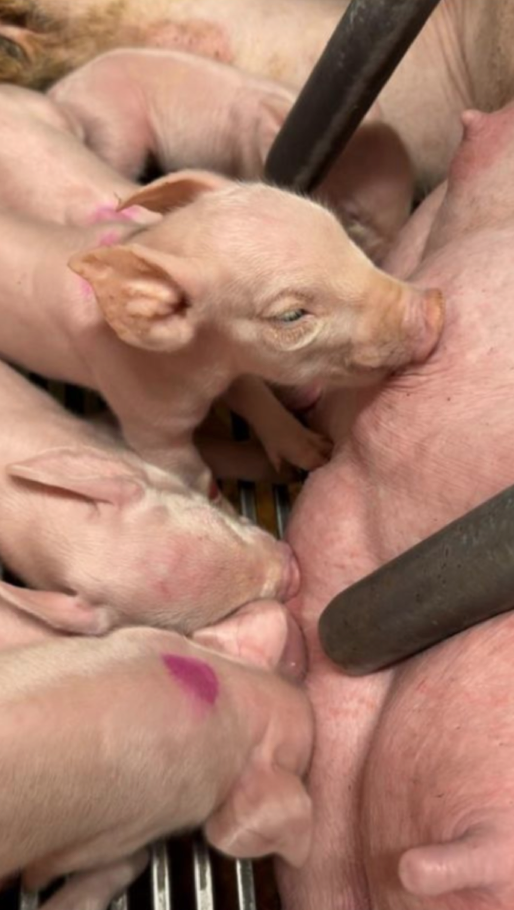
Piglets have one of the most complex nursing behaviours among mammals, writes Madonna Benjamin of Michigan State University on the Pork Business website.
The sow continuously exposes the piglets in the initial hours after birth and colostrum is always available.
Newborn piglets perform the so-called ‘teat sampling behaviour’ for the first eight hours.
Piglets compete over any functional teat as they move along the udder. Each piglet can suckle from seven different teats during this period, and the highest frequency of fighting occurs around three hours after birth, Benjamin wrote.
In the next stage of nursing milk, teat sampling behaviour evolves into synchronized suckling bouts over the first 12 hours.
The sow initiates the nursing in early lactation.
David Fraser found that the sow’s milk ejection is remarkably brief, lasting only about 10 to 25 seconds during the established lactation because the sow’s mammary gland cannot hold large volumes.
Milk is available to the piglets only during milk injection. When the sow calls, the piglets are present and in position during this brief suckling event.
There are five stages or phases to piglet nursing: nursing initiation, pre-ejection, milk ejection, post-ejection and nursing termination.
Most of a sow’s piglets begin to suckle and get settled permanently at their chosen nipples after two to three days of age.
Suckling event frequency averages 25 times in 24 hours with diminished frequency throughout the lactation.
Suckling synchronization and teat fidelity of litter mates is achieved by day three or four after birth.

However, sow prolificacy (number of pigs born) does not equate to more colostrum production by the sow. Subsequently, managing piglets requires strategies to equate the number of functional teats to the number of piglets, understanding how piglets select their choice of teats and understanding the exciting phenomenon of piglet teat fidelity
Research has demonstrated that an intake of about 180 grams of colostrum per kilogram of body weight is required to provide the piglet with sufficient energy and IgG for survival.
A sow’s colostrum production is independent of litter size and overall litter weight.
There was an overall decrease of 22 grams of colostrum per additional piglet born in large litters.
Therefore, in larger litters, piglets are more likely to have a reduced or inadequate colostrum intake due to competition.
If the litter is undisturbed, the piglets will have chosen their preferred teat by day three of nursing.
By day 10, 85 per cent will have kept the same preferred teat pairing.
This study suggests that, when possible, a high level of teat fidelity is an advantage to piglets because it reduces teat disputes and the chance of missing nursing, Benjamin found.
When we can retain good sow health, sow comfort to reduce her heat stress and ensure access to teats, then it is likely that management methods, split suckling, or cross-fostering, would affect litter teat fidelity, she said.
However, if there are limited resources, such as less access to teats than piglets and an attempt to establish or maintain their position in the teat order, fighting would be one negative outcome of this mismatching of established and desirable teats.
Fighting behaviour during lactation can reduce individual piglet milk intake and increase stress, injuries and susceptibility to disease.
However, if managed appropriately, the overall outcomes might improve piglet well-being, she said.
When there are more piglets than teats, litter management strategies such as cross-fostering piglets away from their selected teats may have positive long-term impact on survival, growth, behaviour, reproductive success and immunity.
For example, if cross-fostering to improve access to sow colostrum and milk is conducted more than 20 hours after birth (or one day after birth), there have been no adverse effects on adopted piglet survival and growth performance. Further, cross-fostering in the first two weeks of life might increase socialization and reduce subsequent aggressive behaviours such as tail-biting in the nursery or grower stage.
Additionally, in a gilt’s first lactation, farmers must maximize her capacity for both current and future mammary development. Matching piglet numbers to functional teats ensures teat development for the subsequent pregnancies.
Dr. Chantal Farmer, a Canadian federal agriculture department researcher, found that for those teats to have an adequate milk yield for subsequent litters they must be used in the first parity for at least two days of suckling.
Thus, the piglet’s loyalty to suckling their chosen teat is also responsible for establishing and maintaining milk production and is increasingly important with sows that have larger litters after the first pregnancy, Benjamin said. •
— By Jim Romahn




